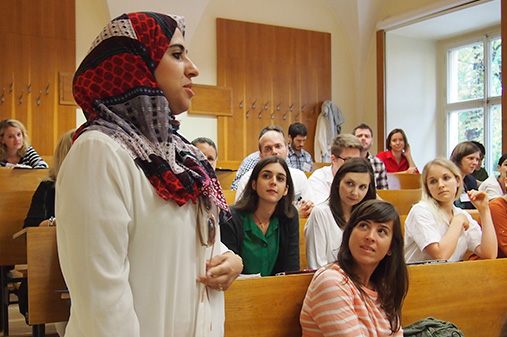Gender differences in DBS decision making
[00:00:00] Dr. Sara Schaefer: Hello and welcome to the MDS Podcast, the official podcast of the International Parkinson and Movement Disorder Society. I'm your host, Sara Schaefer and the Deputy Editor of this podcast, and I'm here with Dr. Michelle Fullard, who's an assistant professor of neurology at the University of Colorado.
View complete transcript
And we're gonna be talking about her recent first author publication in Movement Disorders Clinical Practice in the April, 2025, issue on gender differences in decision making for deep brain stimulation in patients with Parkinson's Disease. Thanks for joining us, Dr. Fullard.
[00:00:43] Dr. Michelle Fullard: Oh, thank you for having me.
[00:00:44] Dr. Sara Schaefer: Let's start with a little bit background about what is known about how women approach surgical decision making in general, not just in DBS.
[00:00:54] Dr. Michelle Fullard: Yeah. What we know from other elective surgeries which a lot of that's come out of joint replacement, [00:01:00] is that women experience more barriers than men when considering a surgical treatment option. And some of these barriers we see in Parkinson's as well. And. Includes fewer referrals to specialists, less social support potentially having a caregiving role that's harder to step away from.
And multiple studies have also shown that women receive less information about surgery as a treatment option. And this goes along with findings that women also report feeling less informed. And so that makes the decision making process harder. They experience more decisional conflict and are just more uncertain about the decision.
[00:01:34] Dr. Sara Schaefer: And what is known about people with Parkinson's in general and how they approach DBS decision making.
[00:01:42] Dr. Michelle Fullard: So we do have a few studies that have come out in the last few years looking at decision making for DBS and many show that people with Parkinson's do prefer to be actively involved in the decision making process. And that for the most part, they feel pretty informed about the treatment options.
Although many [00:02:00] later report after making the decision, they found out either information about what they chose or that there were other treatments available that they didn't know about. And that's been pretty common across multiple studies. Then thinking about women in particular there are studies showing that women are more likely to decline DBS even when offered, and that they are more fearful of complications compared to men.
And there's one interview study showing that compared to men, women are more likely to hesitate and wait when considering DBS. We also know from other epidemiologic studies that women make up only 23 to 30% of DBS recipients. And this really hasn't changed over multiple decades despite making up, at least 40% of the Parkinson's population.
And there are probably a lot of factors that play into that. Differences in preferences, but and some of the others factors we've talked about. But I think decision making is part of that too.
[00:02:54] Dr. Sara Schaefer: You mentioned the disparity between men and women in [00:03:00] DBS, and we also know, of course, that racial minorities, rural residents, lower income persons with Parkinson's may be less likely to get DBS either related to access or other things. Is this disparity what inspired you to do this project or were there other things that went into that inspiration?
[00:03:20] Dr. Michelle Fullard: Yeah, so that was a really big part of it. If I look all the way back to my fellowship, I remember during our DBS evaluation clinic, just wondering where the women were, so many of the candidates we saw were men. And so that started me down this road. And then I had one patient in particular, a woman who was considering DBS.
But just had so much trouble making the decision. She was debilitated by dyskinesia took many years, finally decided to undergo surgery and completely changed her life. Got her social life back, was doing things she enjoyed and of course, said she wish she had made the decision much earlier.
Really she's one that I think about a lot when trying to really [00:04:00] understand the approach to decision making for DBS.
[00:04:03] Dr. Sara Schaefer: Now a lot of our listeners are probably pretty familiar with quantitative research and quantitative studies, but your study used semi-structured interviews with coding for themes and interviewing until you reach saturation and all of these things. And before we get into your methods in more detail, I just wanted to have you talk a little bit about qualitative research and analysis for those who may be less familiar with these techniques and let us know why you chose qualitative as opposed to a quantitative approach to answer this particular question.
[00:04:39] Dr. Michelle Fullard: Yeah. One of the reasons we chose it is that qualitative analysis would really allow us to dive deeper into the experiences of people with Parkinson's considering DBS and reasons behind decision making. And it is very different from quantitative analysis. I was trained in quantitative, so I've learned a lot about qualitative [00:05:00] analysis over the years.
So like you mentioned, we use semi-structured interviews, and this is an interview in which the interviewer has a predefined set of usually open-ended questions. But there's flexibility to explore topics that come up. And if a new topic comes up, the interviewer can dive deeper into that, ask follow up questions, and that allows for the discovery of new information that we may not have anticipated.
And so all of these interviews are recorded, then they're transcribed and a lot of different approaches can be taken to analyze the data, just depending on the research question. For this study, we chose content analysis and that's where usually at least two team members will review the transcripts.
And then like you mentioned, we'll code the data. So we take each segment of text and give it a code. So that might be, if someone's discussing the risks of surgery, then we'll code that as surgical risks. Or if they're talking [00:06:00] about the support that they received during decision making, we would code it that way.
And then after we've gone through multiple transcripts, we'll have a code book that lists all the codes and their definitions so that anyone in the team can go back to a different transcript and code all of the information in there. And once we've done that, so it can be a lengthy process, we can then query the codes, so we can bring up all the codes on concerns about surgical risk from every single participant.
And then from there we can, discover the themes or see what themes emerge from the data. And usually we're keeping different kinds of codes together if they're similar. And then from there the themes will emerge. And as you mentioned, we'll usually recruit patients until thematic saturation is reached.
So that's the point at which if we kept interviewing it would just repeat what's already been discovered. So no new information is coming out of the interviews.
[00:06:55] Dr. Sara Schaefer: Can you dive a little bit more into the methods for this particular study? [00:07:00] Obviously you did semi-structured interviews until you reached saturation. How did you recruit participants? Who were they?
[00:07:07] Dr. Michelle Fullard: Yeah, so this was one center study. So this was done at the University of Colorado and we used something called Purpose of Sampling. So this is where we identify specific people to be part of the study based on certain characteristics. So for our study that included patient gender.
Marital status, their caregiver support, and whether or not they decided to undergo DBS surgery. So we're making sure that we have people who meet different characteristics that we can capture a diversity of the patient experience. And we really wanted to make sure we included an equal number of women and men and also see people women and men with and without caregivers so we could fully understand the experience with decision making.
[00:07:52] Dr. Sara Schaefer: So after all of this, you landed on four core themes, right? The first being [00:08:00] information sources related the second being, the motivation for DBS surgery being very personal, the third being that the decision making process was sometimes a lengthy one, and the fourth being that there were concerns about surgery and the risks, but this was tempered by a trusting relationship with the DBS team and trust in the surgeon.
Let's dive into theme one, which was the information sources theme. This is the theme that I found very fascinating from the perspective of the gender differences. Can you talk about the similarities and differences that you found between men and women within this theme?
[00:08:43] Dr. Michelle Fullard: So we found that for the most part, information sources were pretty similar. So most participants received information from their neurologist and they seemed to really value the information they received from their neurologist and whether or not their neurologist thought they were a candidate.
And then other sources [00:09:00] included YouTube videos. A lot of people were looking at their local and national Parkinson's organization websites, listening to webinars. And many talked to other people who had undergone DBS. Or if they couldn't find someone who had undergone DBS, expressed that they really wish they had spoken with someone.
And for the most part, people were finding their information in these ways. And some of the differences we found was that women really wanted to know more information about what their hair would look like afterwards. How much would we have to shave off? How long would it take to grow back?
Would it grow back the same? And, they said it wouldn't necessarily change whether or not they would get DBS, but it would potentially make them more comfortable with the decision and more prepared with what to expect afterwards. And one thing that we heard over and over from women was that they really wanted to talk with other women who had undergone surgery, but they had a hard time finding these women.
So when they went to support groups, it was the men who had DBS but they really valued hearing the [00:10:00] experience of another woman and what it was like for them but had trouble finding them. And then lastly, women also just wanted to know what support they would need before during and after surgery.
'cause many like we've seen in other studies, either lived alone or didn't have a care partner.
[00:10:16] Dr. Sara Schaefer: I thought it was also interesting that people felt in general that they were less informed about the nitty gritty of the surgery itself and what that experience would be like. That's the kind of conversation I generally leave to the surgeon, right? To talk about how much are you gonna shave of the head and how big of an incision is it?
And what is the immediate postoperative recovery time, and what am I gonna be able to do and not do for how long? And those types of things. And wonder if you feel like. Some of that stuff needs to be included in the counseling from the neurologist, or if we need to just, give this paper to our neurosurgical colleagues and ask them to be a little bit more effusive [00:11:00] about their counseling.
[00:11:01] Dr. Michelle Fullard: Yeah, so I think one, we're working on a decision aid that will have a lot of this information in there. So it's more of a centralized place that people can go to get all this information. But two, what we heard from a lot of people is that they just didn't know what they didn't know.
They didn't know what to ask, or maybe they heard it, but it didn't stick because they didn't know how important it would be to know about it afterwards. So I think probably both of those played a role.
[00:11:28] Dr. Sara Schaefer: Yeah, and as you said, from other patients, they want to hear these things as well.
[00:11:32] Dr. Michelle Fullard: Exactly.
[00:11:33] Dr. Sara Schaefer: Within your other themes, what gender differences struck you in particular?
[00:11:37] Dr. Michelle Fullard: One of the big ones was just the support and that seemed to show up throughout all four of the themes. But that many of the women just said they didn't have support in the decision making process or after surgery. Or they didn't even know how to set up support with family and friends because they weren't sure what they needed after surgery.
And many of the men in the study had care partners or [00:12:00] spouses and when asked if they had any concerns about support said I, I have my spouse, they'll be there. And another thing that struck me as we went through all the interviews was that. When women were weighing the risks and benefits, they seemed to be weighing the risks and benefits, of DBS.
Weighing the risk of surgery versus the potential symptom improvement, but also weighing the risks and benefits to others. Mentioning. , if I don't undergo surgery, I'll be a burden on my family because of worsening Parkinson's symptoms. But if I do well, then there's the burden of post-surgical care and who will take care of me.
So it seemed like they were weighing a lot of risks and benefits, to themselves and others.
[00:12:38] Dr. Sara Schaefer: Not very surprising, I guess, you know, given the disparities between a caregiver role of women But still very interesting to think about and important to think about for sure. Is there any particular quote from the interviews that has stuck with you?
[00:12:55] Dr. Michelle Fullard: So I think it goes along the same lines as the [00:13:00] support. But there was this one woman that we asked all the participants, did you have concern about support? And I don't think we had the full quote in the paper. But she said, well, my husband is my main support and I trust him and I count on him.
So I don't have any concerns in some sense, but in another sense, I don't wanna overburden him. I'm thinking about what kind of help he'll need in supporting me after surgery. So even for a woman who had that built in support, she was worried about how to support him. So just that added level of concern.
[00:13:32] Dr. Sara Schaefer: How have your results changed the way that you approach patients for whom you think DBS should be considered or counsel them through this process?
[00:13:42] Dr. Michelle Fullard: I think it's changed my approach in a few ways. One, just making sure that if a patient in front of me is a candidate for DBS, then I'm bringing it up because we know from other studies that implicit biases, it's something we all have and women just aren't offered these surgical therapies as often.
[00:14:00] So just making sure that I'm offering them to anyone who might be a candidate. And then like we talked about before, women really wanted to talk with other women who had surgery before. So I created a DBS Ambassador program here at Colorado where anyone who is a DBS candidate will be matched with somebody based on a few characteristics, which might be gender, whether they have a care partner, so that they can really hear from someone else in a similar situation, what surgery was like what the post-surgical period was like. And we've found that's really helped women in the decision making process here, what the experience was like for other women.
[00:14:37] Dr. Sara Schaefer: That sounds like a great program. We have DBS support groups and things like that where people can go and ask questions, but there isn't this pairing that you're talking about. Sounds like a wonderful way to approach it.
[00:14:48] Dr. Michelle Fullard: And we found that it's really helped create a community too. So instead of, we thought, women might get on the phone with each other, but they're meeting for coffee, they're going out and doing other things. And so it's really helped now create that community [00:15:00] too.
[00:15:01] Dr. Sara Schaefer: Any final thoughts for our listeners today?
[00:15:04] Dr. Michelle Fullard: One, something else that I've started doing more too is just with the support lacking for a lot of women that we found in this study, we're just really making sure that we set women up for success with DBS. So whether that's, just talking through the support that they'll need or even setting up home health if needed.
But I think for any DBS candidate, but for, especially for women, just making sure they have that support in place.
[00:15:27] Dr. Sara Schaefer: Thank you very much for sharing all these insights with us today, Dr. Fullard
[00:15:32] Dr. Michelle Fullard: Thank you for having me.
[00:16:00]

Michelle Fullard MD, MS
University of Colorado
Denver, CO USA









